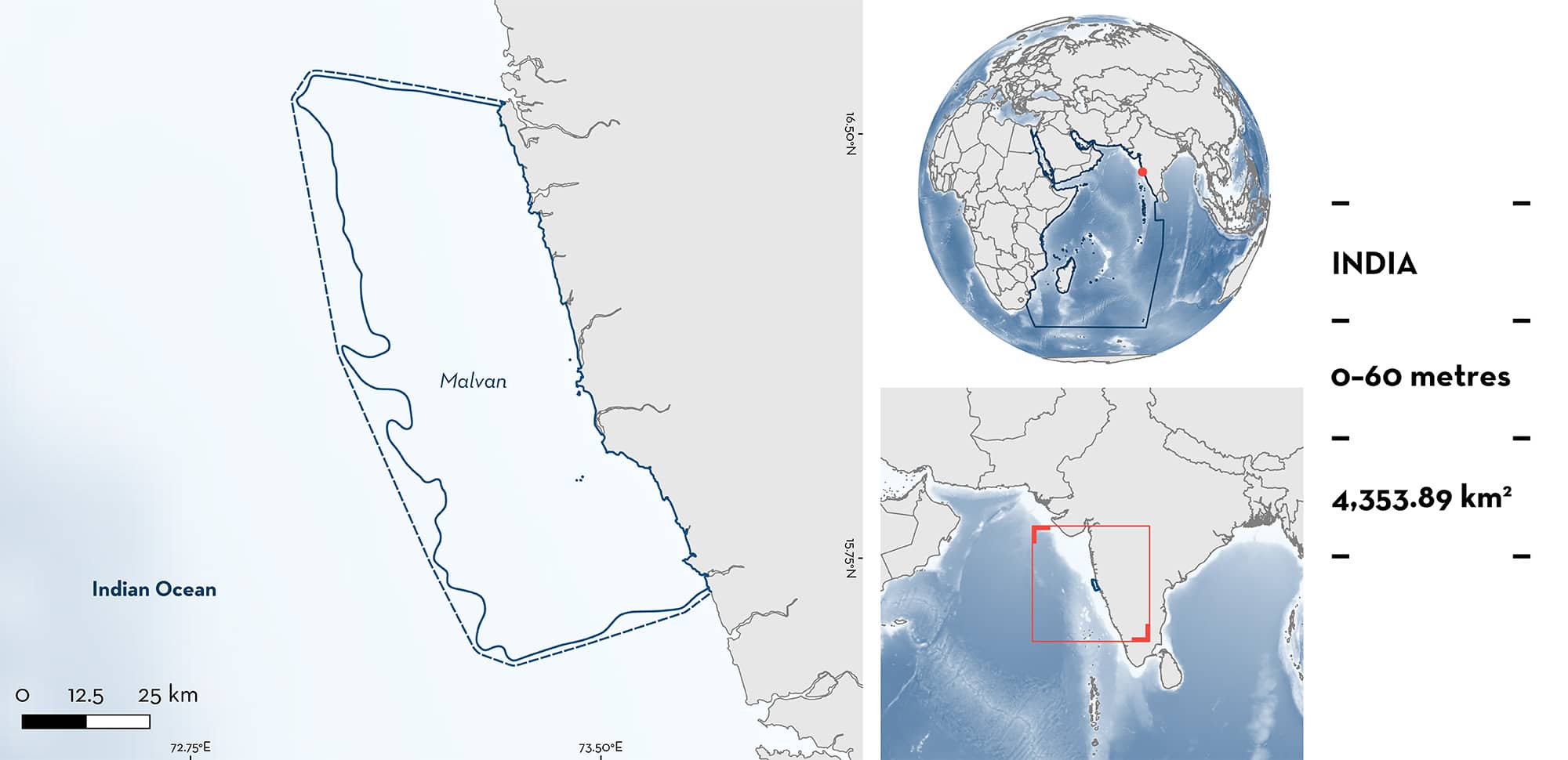ISRA FACTSHEETS
ISRA FACTSHEETS
WESTERN INDIAN OCEAN REGION
Malvan
Summary
Malvan is located in Sindhudurg district of southern Maharashtra on the west coast of India. The area encompasses inshore, coastal, and continental shelf waters. The coastline is dominated by rocky outcrops with intermittent sandy beaches and is indented with estuaries and creeks. Within the area there are: threatened species (e.g., Longhead Eagle Ray Aetobatus flagellum); and reproductive areas (e.g., Widenose Guitarfish Glaucostegus obtusus).
Download factsheet
Malvan
DESCRIPTION OF HABITAT
Malvan is located in coastal and continental shelf waters of Sindhudurg district of Maharashtra state on the west coast of India. The area encompasses shallow inshore and coastal waters and includes a variety of habitats, such as mangroves, rocky and intertidal areas, sandy beaches, and coral reefs (both soft and hard corals). The coastline is dominated by rocky outcrops with intermittent sandy beaches and is indented with estuaries and creeks (Fenton & Saxena 2015).
The area is influenced by tropical monsoonal conditions. The pre-monsoon season spans January-May, the monsoon spans June-July, and the post-monsoon spans August-December. Malvan is one of the most biologically rich coastal regions of Maharashtra with a rich phytoplankton diversity (Hardikar et al. 2017) supporting a diverse marine ecosystem and highly productive fisheries.
The area overlaps with the Malvan Marine Sanctuary and the Burnt Island (Bandra) Vengurla Rocks Key Biodiversity Area (KBA) (KBA 2023).
This Important Shark and Ray Area is benthopelagic and is delineated from inshore and surface waters (0 m) to 60 m based on the bathymetry and occurrence of the Qualifying Species in the area.
CRITERION A
VULNERABILITY
Seven Qualifying Species considered threatened with extinction according to the IUCN Red List of Threatened SpeciesTM regularly occur in the area. Threatened sharks comprise one Critically Endangered species and three Vulnerable species; threatened rays comprise two Critically Endangered species and one Endangered species (IUCN 2023).
CRITERION C
SUB-CRITERION C1 – REPRODUCTIVE AREAS
Malvan is an important reproductive area for four shark and three ray species.
Landing surveys for sharks and rays conducted at the main landing site in Malvan during March–May 2018 and October 2018–May 2019 (Gupta et al. 2020) and between February–May 2018, October 2018–May 2019, and December 2019–March 2020 (Kottillil et al. 2023) recorded catches from coastal gillnets, trawlers, and artisanal fisheries that operate in the area. Data collected overlaps between these two studies with reproductive data here presented primarily from Gupta et al. (2020) apart from information on Spottail Shark which is from Kottillil et al. (2023).
Sharks and rays were considered to be neonates based on their size (published size-at-birth is provided for comparison when available) and the presence of umbilical scars. Dissections provided data on pregnant females and females that had recently given birth. The low occurrence of adults of some species, and therefore pregnant females, in the catch can likely be attributed to fisher behaviour (who reportedly do not target adult sharks) and size-selectivity of the fishing gear, particularly in gillnets (Gupta et al. 2020).
Observed landings between March 2018 and May 2019 included 49 Bull Sharks of which 40 were examined and 30 (75%) were neonates and young-of-the-year (YOY) with a mean size of 81.4 cm total length (TL) (range: 72–92 cm TL) (Gupta et al. 2020). Published size-at-birth is 56–81 cm TL (Ebert et al. 2021). Neonates were regularly recorded during January to April (Gupta et al. 2020).
Observed landings between March 2018 and May 2019 included 338 Blacktip Sharks of which 245 were examined including 129 neonates and YOY (53%) with a mean size of 71.7 cm TL (43.2–100 cm TL) (Gupta et al. 2020). Published size-at-birth is 38–72 cm TL (Ebert et al. 2021). Neonates were regularly recorded during January to March (Gupta et al. 2020). A single pregnant female was also recorded in February (Gupta et al. 2020).
Observed landings between February 2018 and March 2020 included 41 Spottail Sharks of which 37 were examined with all but two individuals neonate or YOY (95%) with a mean size of 77.8 ± 28.6 cm TL for females and 67.8 ± 4.5 cm TL for males (Kottillil et al. 2023). Published size-at-birth is 45–60 cm TL (Ebert et al. 2021).
Observed landings between March 2018 and May 2019 included 653 Scalloped Hammerheads of which 357 were sampled including 102 neonates (29%) with a mean size of 47.9 cm TL (42.7–55.5 cm TL) (Gupta et al. 2020). Published size-at-birth is 31–57 cm TL (Ebert et al. 2021). Neonates were regularly recorded during November to January (Gupta et al. 2020). A single pregnant female was also recorded in December and there is some anecdotal evidence that pregnant females are caught between September and December (Gupta et al. 2020).
Observed landings between March 2018 and May 2019 included 309 Longhead Eagle Rays of which 178 were sampled including 70 neonates (39%) with a mean size of 27.6 cm disc width (DW) (23–29.8 cm TL) (Gupta et al. 2020). The smallest free-swimming individual in the literature measured 23 cm DW (Last et al. 2016). Two adult females recorded in April and October had recently given birth (Gupta et al. 2020).
Observed landings between March 2018 and May 2019 included 74 Sharpnose Guitarfish of which 64 were sampled including 18 neonates (28%) with a mean size of 39 cm TL (20.6–49 cm TL) (Gupta et al. 2020).
Download factsheet
SUBMIT A REQUEST
ISRA SPATIAL LAYER REQUEST
To make a request to download the ISRA Layer in either a GIS compatible Shapefile (.shp) or Google Earth compatible Keyhole Markup Language Zipped file (.kmz) please complete the following form. We will review your request and send the download details to you. We will endeavor to send you the requested files as soon as we can. However, please note that this is not an automated process, and before requests are responded to, they undergo internal review and authorization. As such, requests normally take 5–10 working days to process.
Should you have questions about the data or process, please do not hesitate to contact us.


